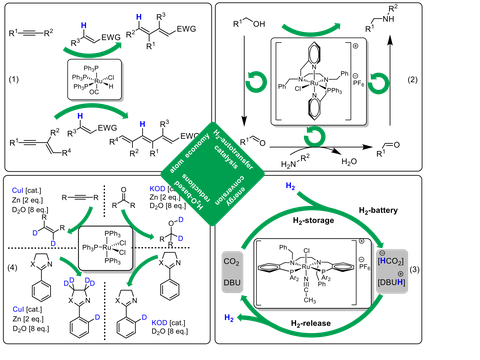Development of novel catalytic transformations - Catalysis to increase resource efficiency
Catalysis to increase resource efficiency
In the Plietker-group, the development of "sustainable catalysis" has been a core research area for many years (it was the subject of the habilitation thesis).
The development of an atom-economic direct hydrovinylation of alkynes to di- and trienes using a defined Ru complex might serve as an early example (eq. (1)).
Specially designed (NNNN,P)-Ru complexes have been used for hydrogen auto transfer catalysis in which alcohols act as environmentally benign alkylating agents in C-C and C-N bond-forming reactions (eq. (2)).
Changing the donor atoms in the otherwise almost identical ligand backbone enables the efficient reduction of ketones by hydrogenation or transfer hydrogenation but also the reversible reduction of CO2 to formic acid (eq. (3)).
Very recently, a broadly applicable Ru-catalyzed chemoselective reduction of ketones, alkynes, or organonitro compounds was developed. The introduction of different additives to (Ph3P)3RuCl2 led to the in-situ formation of different Ru complexes, which show orthogonal chemoselectivities in the reduction of functional organic compounds in the presence of zinc and water (eq. (4)). With the help of this method, natural and active substances can be regio- and chemoselectively deuterated by zinc and D2O.

